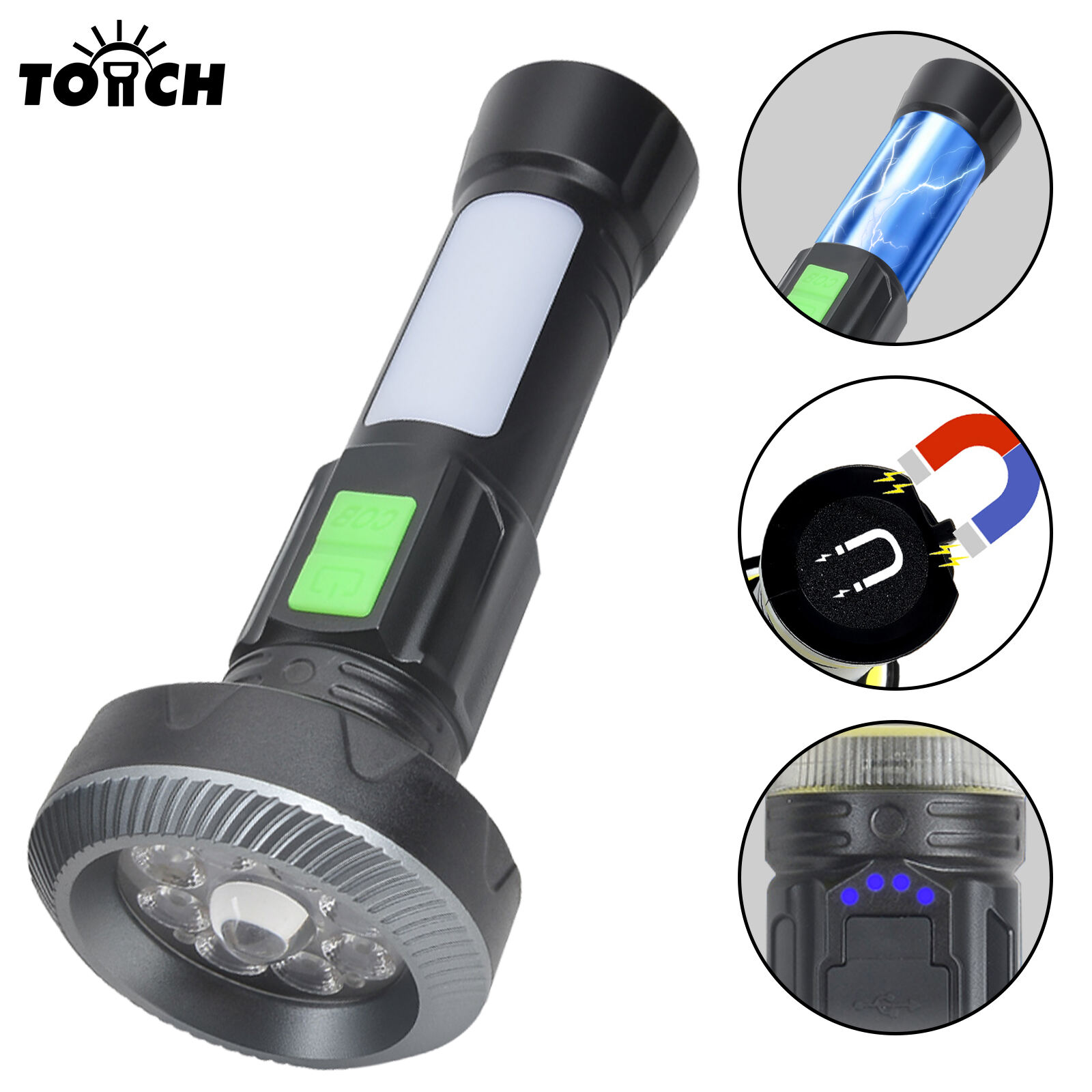何がそれを構成するかを理解する 懐中電灯 信頼性があり 耐久性がある
フラッシュライトにおける信頼性の定義
話をすると 懐中電灯 信頼性とは、さまざまな状況や長期間にわたり、製品がどれだけ確実に機能し続けるかということです。優れた懐中電灯は、真冬の寒い夜であろうと森の中を雨天でハイキングしているときであろうと、必要なときにしっかりと点灯する必要があります。星の下でキャンプを張る人や非常時に備える人にとって、このような信頼できる照明は非常に重要です。誰もが、最も必要としているときに懐中電灯が突然壊れるような状況には陥りたくありません。そのため、本格的なアドベンチャーや緊急対応に携わる人々は、高品質な照明に投資することが、予期せぬ出来事にも備えることになると理解しています。
考慮すべき主要な耐久性要因
懐中電灯の耐久性は 材料と組み立ての質によって異なります 飛行機用アルミや 耐久性のあるポリマーで 作られています 時間が経つにつれて分解しません 材料はあらゆる種類の乱用にも 耐えなければなりません 特にガラスレンズや 小さなスイッチ機が まず損傷する傾向があります 深刻な仕事や軍事用に使われる懐中電灯を 見てみると 高さから落とされたり 道具袋に投げ捨てられたりすると 裂かないものが必要です 緊急事態や 野外での厳しい状況下で 照明が機能し続けなければ 結構です 重要な時に 懐中電灯が故障するのを 誰も望まないからです
製造基準の役割
懐中電灯 の 信頼性 と 持続 力 は,実際 に 製造 基準 に 十分 準拠 する か に かかっ て い ます. 例えば ANSI/FL1では 懐中電灯の明るさや 充電で長持ちし 落下やぶつかる時の耐久性について 明確なガイドラインを定めています 製造者がこのような基準に従うと 顧客は購入前に 商品が何を求めているか 分かるようになります 品質の安心感だけでなく 継続的に機能する製品も 受け取ります 懐中電灯の購入を考えている人にとって 業界基準に適合しているかどうか調べるのは 良い実践だけでなく 途中で 予期せぬ故障なく 最も必要な時に機能するものを 欲しがるなら 基本的に不可欠です
信頼性のある懐中電灯の基本的な特長
電池寿命と電源オプション
良き手電灯のバッテリー寿命は,何時間も光が必要になる時に本当に重要です. 懐中電灯 を 選ぶ とき,充電 可能な 電池 と 使い捨て 電池 の 選択 は,その 電灯 が 日常 に どの よう に 役立つ か に 大きく 影響 する. 充電可能な電球は 時間の経過とともに 費用を節約し,もし誰かが電球を頻繁に使用するなら 環境にも良いのです 充電器がない場合でも 備蓄として使えます 充電器がない場合でも 備蓄として使います 異なる種類の電池で動作する懐中電灯は,ユーザーにより柔軟性を与えます. 標準的なAAまたはAAA電池と特殊なリチウムパックも搭載している. この種の多用性は 荒野にハイキングしたり キャンプしたりする人にとって 素晴らしいものです 電気の利用が 数日間 制限されている場合もあります
明るさモードと調整可能な出力
照明レベルを調整できる機能により 懐中電灯は 固定設定の1つだけよりも 様々な状況で ずっと便利です 現代の懐中電灯は,多くの明るさオプションが付属しており,ユーザーが必要なものに応じて低,中,高の設定を切り替えることができます. 夜に地図をチェックしたり 夜になると道を見つける時 この柔軟性は重要です 灯りを低調に設定できれば バッテリーも節約できます だから,普通に使うときも 懐中電灯を低調に設定している人が多いのです しかし緊急事態が起きたら 危険状況で信号を出すために 高い位置に設定された信号が 必要になります 良き手電筒 は,常に 交換 さ れ ない こと や 特別な 配件 が 必要 な こと で は なく,どんな 出来事 も 対応 できる もの で ある べき です.
ビーム距離と焦点の柔軟性
ライトが実際にどこまで届くかを教えてくれます ライトが実際にどこまで届くかを教えてくれます 夜間検索をする必要のある人にとっては とても重要なものです 束の距離を制御できる懐中電灯は 物事が変化し続ける状況で よりうまく機能します 焦点を調整する能力も 違いを生むのです 暗闇に広がる狭い光線から より広い光線に切り替えることができます 詳細を近距離で確認できます この多用性によって どんな状況でも 手電灯は使えます 日没後の簡単な散歩から 困難な地形での 深刻な救助活動まで これらの機能は 前にあるどんな課題にも 適切なツールを持っていることを保証します
製造品質と素材の評価
アルミニウム対ポリマー:それぞれの利点と欠点
懐中電灯のアルミとポリマー構造の 選択は ユーザーにとって 最も重要なものなのです アルミのモデルは耐久性があり 熱を処理する能力が高く 田舎での困難な作業に 使われるのが 理由です この金属のライトは 汗をかきずに 罰を受け入れてるみたいです 一方 ポリマー懐中電灯は 異なるものを生み出しています 湿ったり 塩水に晒されたりしても 腐らないのです 背負って行きたくないので 歩行者やキャンプ客はよくこれを選びます 結局のところ この2つの選択肢の選択は 普段の人がどんな状況にいるかによって決まります 余分な強さのために 体重を少し犠牲にする人もいますが 背中に二度考えずに 投げ込むようなものが 必要なのです
アノダイズ仕上げの重要性
アロジ化コーティングは アルミの懐中電灯の耐久性を高め 腐食から守ります 金属表面にシールドを貼り付けます 荒野の環境でも 長く生き延びられるようにします シンプルで実用的な外見だけでなく 手のひらに手電筒の感触も 変えています 熱帯電球は 牽引力が高くて 重要な瞬間には 指が滑らない 夜間ハイキングや 救助任務などで 毎秒が大切になります 装置の故障が選択肢でない厳しい環境で働く人にとって 陽化懐中電灯を選ぶことは 信頼性の高いパフォーマンスと 最も重要なときに 手軽な操作の両方を 得るということです

長寿命のために密封された部品
密封された部品は 懐中電灯を数ヶ月ではなく 何年も 強く保つものです 部品が適切に密封された場合 水や汚れが入って行かないようにします 屋外や 防空や汚れが常の問題である 作業場で 懐中電灯を 使う必要のある人にとって これは非常に重要です 質の高いシールが 素晴らしい効果を及ぼします 低価格モデルよりも ライトが長く保たれます この方法で作られた手電筒は どんな状況でも信頼できる仲間になります 雨 の 中 に キャンプ へ 戻る 道 を 見つけ て いる と いう こと を 考え て み ましょ う. 密封がしっかりした手電筒に 少し余分なお金を使うと 何度も何度も 状況が違っても 明るく輝くようになります
防水および衝撃耐性基準
防水性能におけるIPレーティングの理解
IP評価は電球が水や塵に どれだけ耐えるかを判断するのに 大変重要です IPX7を例に挙げると 基本的に光が損傷を受けずに 1メートル深の水中に 浸透してもらうことができます ランキング番号が高くなるほど 懐中電灯はよりよく保護されます 厳しい環境下で外で使っているか 意外な修理作業中に家の周りを回っているか 違いはあります この評価が何を意味するのかを知ることで 人は自分がどんな状況にあるにせよ 適切な手電筒を選びます 家庭で停電したときに 予備照明を 探している人よりも 高い評価のものが 必要かもしれません 湿った天候で電球が壊れてしまうと チェックするのも考えません
落下および衝撃抵抗のテスト
荒れ果てた地形に出くわしたり 困難な状況に直面したりすると 耐久性のある懐中電灯は まず かなり厳しい 落とし込み・衝突テストに 合格する必要があります 製造者は 灯りを様々な高さから投げて 生き残るかどうかを調べます 通常は 販売場所によって 落ちる量を フィートやメートルで測定します 実験は 登山や救助中に 偶然落下した物について 教えてくれます 屋外愛好家の多くは これがとても重要だと知っています 灯りが最重要時に 消えたくないからです 建設現場や 捜索救助や 軍事部署で働く人々にとって 罰に耐えられる装備は 便利だけでなく 日々安全に仕事をこなすのに不可欠です
なぜ防水性能が重要なのか
現代の懐中電灯に組み込まれた防気装置は 雨や雪や極端な温度から守ります 厳しい環境で 信頼できる照明を必要とする人にとって このような保護は 本当に重要です 嵐を乗り越える山岳徒歩者や 突如降雨に遭うキャンプ客は 電子機器が水分を防ぎきれなかったため 壊れたときに 何が起こるか 直接知っています 予想できない気象圏に入る前に IP67以上のランク付けの懐中電灯を常に探す理由です 暴雨や寒さにも耐えられる装備を 持ち歩いていると 障害なく眠れるので 重要な瞬間も 乗り物には 失望させないという安心感で 夜眠れます
長期的な信頼性のためのメンテナンス方法
清掃 と 保存 の 最良 の 実践
適切に保管された清潔な懐中電灯は より良く働き,長く持ち続けます レンズを定期的に掃除する際には レンズ領域とスイッチメカニズムに 焦点を当ててください 汚れが急速に蓄積して 光の明るさを 減らすからです 懐中電灯を乾燥した場所に置いておくことで 違いが生じます 湿った環境ではバッテリーが枯渇し 他の部品も壊れます 懐中電灯をよく使う人は メンテナンスのための ルーチンを設定することを 本当に考えなければなりません 数ヶ月ごとに? ポイントは,これらの基本的な作業が定期的に行われることです. 誰かが手電灯を最も必要とする時に, 怠慢のために落胆しないように.
電池の手入れと交換のポイント
バッテリーをよく管理することは,懐中電灯の最大利用に本当に大きな違いをもたらす. 蓄電池が長持ちしたいなら 充電時に何が一番効果的か 適切に保管する方法を知るべきです 充電可能な懐中電灯を 特別に扱う場合 誰も電池を電源で電源で電源に繋げて 夜中ずっと残したくないのです 電気バッテリーを 屋内の熱や寒さから 遠ざけることも 挙げられます 新しい電池を設置した後でも 懐中電灯が いつものように明るく ならないか 超速で消耗していることに気づけば それはおそらく 内部電源に何か問題がある兆候です 現代の手電筒の多くは 梱包物や手帳に 特定のバッテリー要件が記載されているので 交換する前に この詳細をチェックすれば 後で頭痛を避け 信頼性の高い状態で 機能します
Oリングとシールの点検
オーリング と 密封 器 を 定期的に チェック する こと に よっ て,手電筒 は 水 や 塵 に 耐える よう に 正常に 機能 し ます. 時間が経つにつれて これらの部分は 磨き去られ 光が雨や泥や 自然がもたらすものに対して 耐えるようにはなりません 懐中電灯 を 持っている 人 は,その 密着 を 時々 見る こと を 習慣 に する べき です.水分 や 汚れ が 中 に 入り て しまう 前 に 損傷 の 兆候 を 示す 密着 を 交換 する こと が でき ます. この メンテナンス は,嵐 の 中 で 歩行 する 時 に も,外出 の 冒険 の 中 で 予期せぬ 雨 を 乗り越える 時 に も,手電筒 を 完全 に 保存 し,信頼 できる もの に なる よう に する こと に 役立ち ます.

